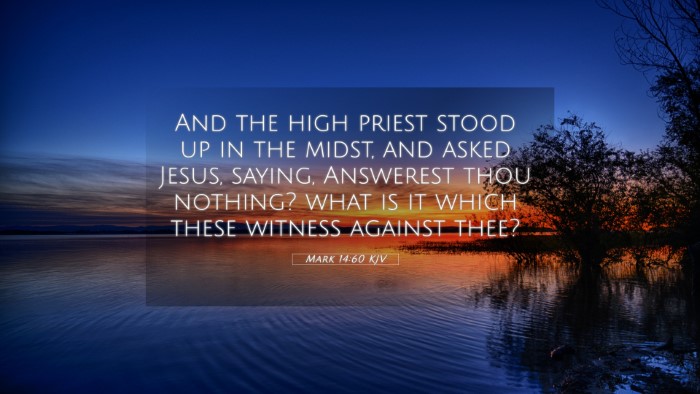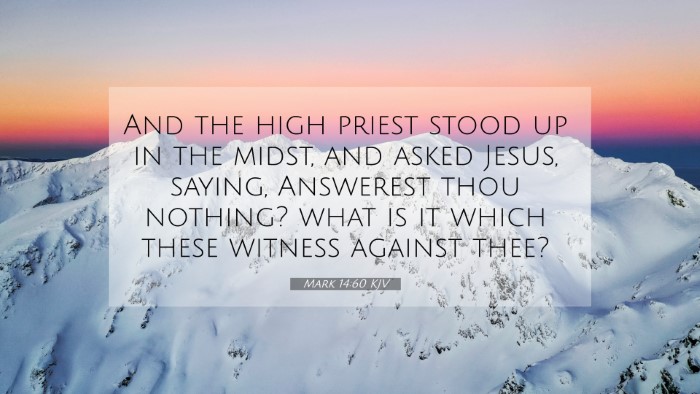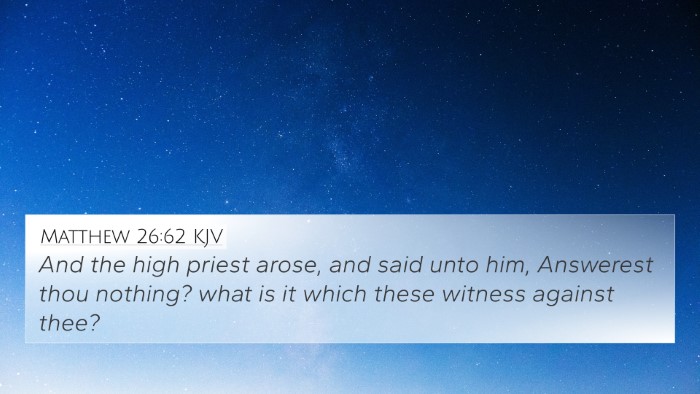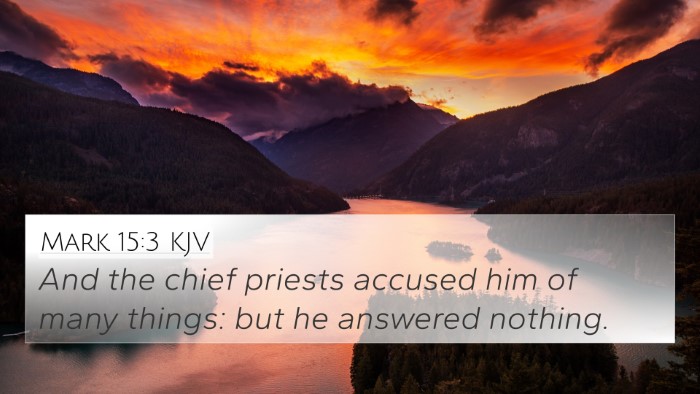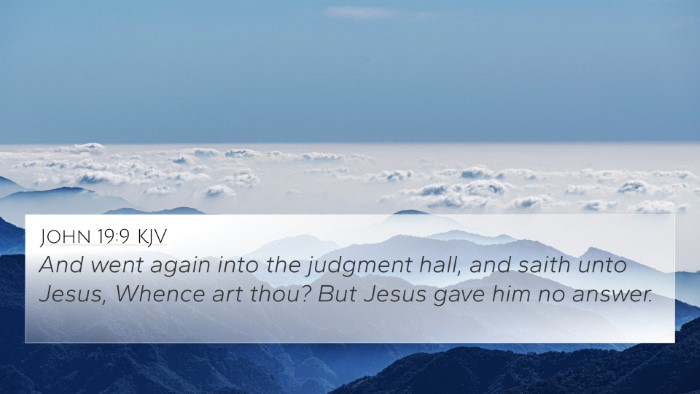Understanding Mark 14:60
Mark 14:60 presents a significant moment during the trial of Jesus, where the high priest directly questions Him about the charges against Him. This verse marks a pivotal point in the narrative of Christ’s passion.
Verse Context
In this passage, Jesus stands trial before the Sanhedrin. The high priest, Caiaphas, is seeking a basis for the accusations that will lead to the crucifixion of Jesus. The verse reads:
"And the high priest stood up in the midst, and asked Jesus, saying, 'Answerest thou nothing? what is it which these witness against thee?'" - Mark 14:60
Commentary Insights
Insights from public domain commentaries enhance our understanding of this verse in various ways:
- Matthew Henry: Henry emphasizes the boldness of the high priest's inquiry. He notes that Caiaphas was attempting to provoke a response from Jesus, perhaps hoping to establish a clear accusation against Him. Henry reflects on the significance of Jesus' silence as fulfilling the prophecy of being led as a lamb to the slaughter (Isaiah 53:7).
- Albert Barnes: Barnes highlights the psychological and theological aspects of the moment. He points out the desperation of the high priest as he tries to secure evidence. This illustrates the lengths to which the religious leaders would go to condemn Jesus, and the contrast of their scheming with Jesus' calm demeanor under pressure.
- Adam Clarke: Clarke provides a historical context, noting that the Jewish law mandated that the accused be given an opportunity to defend themselves. Jesus' silence was a profound commentary on the nature of the trial—a clear injustice unfolding before all who were present.
Thematic Connections
Mark 14:60 connects profoundly with several important themes in Scripture:
- Justice and Injustice: The unfolding scenario highlights the contrast between divine justice and human injustice. This can be further explored in Isaiah 53:5, where the suffering servant bears our iniquities.
- Silence in Suffering: Jesus’ silence is a theme tied to His innocence. This recalls passages like 1 Peter 2:23, which notes His response to suffering.
- Prophecy Fulfillment: The events mirror prophetic fulfillments, notably in Psalm 38:13-14, emphasizing the messianic role of Jesus.
Cross References
Here are key Bible verses that relate to Mark 14:60, illustrating thematic connections and scriptural cross-referencing:
- Isaiah 53:7: "He was oppressed, and he was afflicted, yet he opened not his mouth; he is brought as a lamb to the slaughter."
- Matthew 26:62-63: "And the high priest arose, and said unto him, Answerest thou nothing? ... Jesus held his peace."
- Lamentations 3:28-30: "He sitteth alone and keepeth silence, because he hath borne it upon him." This signifies the theme of isolation in suffering.
- 1 Peter 2:23: "Who, when he was reviled, reviled not again; when he suffered, he threatened not; but committed himself to him that judgeth righteously."
- Acts 8:32-33: A reference to the suffering servant, resonating with the narrative of Jesus’ trial.
- John 1:29: "Behold the Lamb of God, which taketh away the sin of the world!" connects Jesus’ trial to His sacrificial role.
- John 18:19-23: Further details on the trial, reflecting the unfairness of the court proceedings against Jesus.
Tools for Further Study
For those seeking a deeper understanding of the Bible and connections among scriptures, the following tools may prove useful:
- Bible Concordance: A helpful tool for finding specific verses and their occurrences throughout Scripture.
- Bible Cross-Reference Guide: Essential for studying connections and linking Bible verses.
- Bible Chain References: A study method for following themes across various books of the Bible.
- Comprehensive Bible Cross-Reference Materials: Resources that provide an extensive breakdown of scripture relations.
Conclusion
Understanding Mark 14:60 involves recognizing key themes of injustice, prophetic fulfillment, and the silent strength of Christ. By engaging with cross-referencing methods, readers can deepen their knowledge of scriptural texts and their interrelations, enriching both personal faith and collective understanding.
Further Questions for Study
Here are some reflective considerations that may guide further study:
- What do the responses of Jesus during His trial reveal about His character and mission?
- How does the silence of Jesus in this context compare with other moments of vocal expression in the Gospels?
- In what ways does the trial of Jesus inform our understanding of justice and righteousness?
- How can linking Bible scriptures enrich our understanding of individual passages like Mark 14:60?

